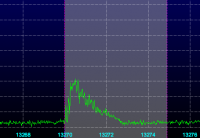Signal Identification
From HFUnderground
(Difference between revisions)
| Line 82: | Line 82: | ||
| FMCW transmission, changes sweep rates in 16 steps, resulting in 16 different sounds per transmission, pilot tone precedes each rate change | | FMCW transmission, changes sweep rates in 16 steps, resulting in 16 different sounds per transmission, pilot tone precedes each rate change | ||
| Unknown | | Unknown | ||
| - | | 16 x 64 sounder recording link here | + | | [[File:16x64_sounder.mp3]]16 x 64 sounder recording link here |
| - | | [[File: | + | | [[File:16x64_sounder.jpg|200px]] |
|- | |- | ||
| PLUTO radar (possible offical name, PLUTO II, suggested by open source documents) | | PLUTO radar (possible offical name, PLUTO II, suggested by open source documents) | ||
Revision as of 04:14, 4 December 2014
Crude mock-up of the start of a signal identification section of the wiki.
Guidelines, goals, structure, and how to use described here.
Contents |
Non DATA Signals
Communications Modes
| Mode | Frequency Range (kHz) | Bandwidth (kHz) | Shift (Hz) | Number of Tones | Key Features | Sources | Recording | Spectrum Image |
|---|---|---|---|---|---|---|---|---|
| AM | All Frequencies in the HF Range | Typically 2.6 to 10.0 kHz, can be wider or narrower | Not Applicable | Not Applicable | Carrier present in center of signal, audio typically mirrored left and right of the carrier | World wide | AM recording link here | 
|
| CW
(Morse Code) | All Frequencies in the HF Range | Very narrow, potentially less than 50 Hz | Not Applicable | Not Applicable | Line or broken line on the waterfall, no sidebands, may show wider "key clicks" at the start and stop of each dot and dash | World wide | CW recording link here | 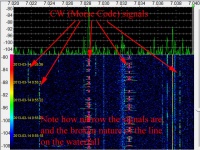
|
| LSB | All Frequencies in the HF Range | Typically 2.4 to 3.0 kHz, can be wider or narrower | Not Applicable | Not Applicable | No carrier present in Spectrum, audio typically bunched to towards the right (low audio frequency) | World wide | LSB recording link here | 
|
| USB | All Frequencies in the HF Range | Typically 2.4 to 3.0 kHz, can be wider or narrower | Not Applicable | Not Applicable | No carrier present in Spectrum, audio typically bunched to towards the left (low audio frequency) | World wide | USB recording link here | 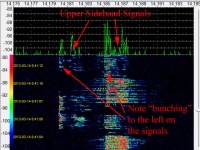
|
Non Communications Modes
| Mode | Frequency Range (kHz) | Bandwidth (kHz) | Shift (Hz) | Number of Tones | Key Features | Sources | Recording | Spectrum Image |
|---|---|---|---|---|---|---|---|---|
| 16 x 64 Sounder (nickname, official name or designation not known) | Below 4000 to above 30000 observed | 3 kHz | Not Applicable | Not Applicable | FMCW transmission, changes sweep rates in 16 steps, resulting in 16 different sounds per transmission, pilot tone precedes each rate change | Unknown | File:16x64 sounder.mp316 x 64 sounder recording link here | 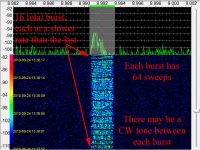
|
| PLUTO radar (possible offical name, PLUTO II, suggested by open source documents) | 8000 to 38000 | 3 to 40 kHz, depending on specific operating conditions | Not Applicable | Not Applicable | FMCW transmission, presenting a wide signal equal to the swept (chirped) width, sweep rate creates a pulsed sound affect | British Sovereing base of Akrotiri, Island of Cyprus | PLUTO recording link here | 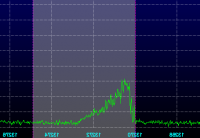
|
Need to put some kind of break here, a line or something, to sep out the Non DATA from DATA
Probably need to put a desription of what is meant by DATA Signals in this area.
DATA Signals
FSK Modes
MFSK Modes
| Mode | Frequency Range (kHz) | Bandwidth (kHz) | Shift (Hz) | Number of Tones | Key Features | Sources | Recording | Spectrum Image |
|---|
PSK Modes
| Mode | Frequency Range (kHz) | Bandwidth (kHz) | Shift (Hz) | Number of Tones | Key Features | Sources | Recording | Spectrum Image |
|---|
SELCAL Modes
| Mode | Frequency Range (kHz) | Bandwidth (kHz) | Shift (Hz) | Number of Tones | Key Features | Sources | Recording | Spectrum Image |
|---|
Image Modes
| Mode | Frequency Range (kHz) | Bandwidth (kHz) | Shift (Hz) | Number of Tones | Key Features | Sources | Recording | Spectrum Image |
|---|
This site is a participant in the Amazon Services LLC Associates Program, an affiliate advertising program designed to provide a means for sites to earn advertising fees by advertising and linking to Amazon.com. Some links may be affiliate links. We may get paid if you buy something or take an action after clicking one of these.
